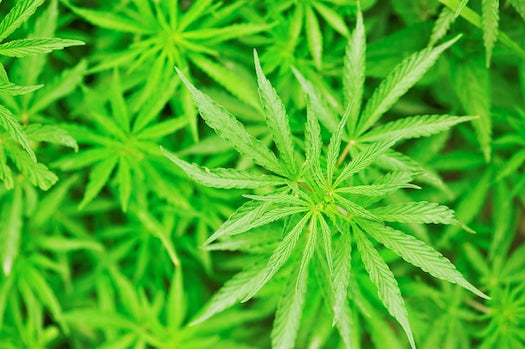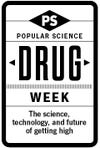Why It’s So Hard For Scientists To Study Medical Marijuana
The nation's research-grade cannabis is controlled by the National Institute on Drug Abuse, whose mission to curb use is at odds with that of researchers looking to study pot's therapeutic properties.


Drug Week
Eighteen states (plus the District of Columbia) allow cannabis use for certain medical conditions. Despite that, scientists have a harder time doing research on the potential medical benefits of marijuana than they do on “harder” drugs like ecstasy or magic mushrooms. The public may think of pot use as no big deal, but federal laws make it difficult for researchers to obtain legal supplies. Clinical researchers can get permission from the DEA to grow or create restricted compounds like LSD, MDMA or psilocybin in the lab; not so with cannabis.
The Controlled Substances Act of 1970 placed marijuana in the most restrictive use category, Schedule I, deeming it a drug with no medicinal value and high potential for abuse. To do clinical research with marijuana, you need a DEA license, and you need to get your study approved by the FDA. When it comes to actually obtaining research-grade marijuana, though, you have to go through the National Institute on Drug Abuse, a process that has proved problematic for some researchers determined to study the potential medical benefits of pot.
“Marijuana is a linchpin in the War on Drugs,” explains Brad Burge, the director of communications for the Multidisciplinary Association of Psychedelic Research (MAPS), an organization currently embroiled in a lawsuit with the DEA over the right to establish a medical marijuana farm. “There’s a lot of investment in marijuana remaining illegal.”
Anecdotal evidence suggests that marijuana can reduce chronic pain, reduce muscle spasms in patients with multiple sclerosis and perhaps even help treat symptoms of PTSD. The small amount of clinical research out there also supports the idea that marijuana could be an effective treatment for pain. A 2007 study found that smoking cannabis reduced chronic pain in HIV-positive patients by 34 percent. Results from a Canadian study in 2010 further supported the theory that it can [reduce the intensity of neuropathic pain–pain caused by damage to the nervous system–and help patients sleep.
If you’re going to run a trial to show that marijuana has positive effects, the NIDA essentially is not going to allow it.
Both the American Medical Association and the American College of Physicians have called for more research into the therapeutic uses of marijuana and for the U.S. government to reconsider its classification as a Schedule I substance.
The University of Mississippi grows and harvests cannabis for studies funded by the National Institute on Drug Abuse, yet because NIDA’s congressionally mandated mission is to research the harmful effects of controlled substances and stop drug abuse, the institute isn’t interested in helping establish marijuana as a medicine.
“If you’re going to run a trial to show this is going to have positive effects, they’re essentially not going to allow it,” Lyle Craker, a professor and horticulturist at the University of Massachusetts Amherst, says.
The federal government’s position on marijuana, according to a January 2011 document featured prominently on the DEA’s homepage, is that
The clear weight of the currently available evidence supports [Schedule I] classification, including evidence that smoked marijuana has a high potential for abuse, has no accepted medicinal value in treatment in the United States, and evidence that there is a general lack of accepted safety for its use even under medical supervision… Specifically, smoked marijuana has not withstood the rigors of science–it is not medicine, and it is not safe.
Burge tells a different story. “The United States government has gone to great lengths to prevent [medical] research on whole-plant marijuana,” he says, though research into isolated components of the plant has gone on.
“We have an FDA-approved protocol, but the only way to actually get marijuana for the study, the only federally approved source, is at University of Mississippi,” he says. “NIDA refused to sell us the marijuana for this study.”
There’s a lot of investment in marijuana remaining illegal.According to NIDA, the agency can provide research-grade marijuana to projects that have received funding from the National Institutes of Health (NIH), or to a non NIH-funded project that has an approved Investigational New Drug application on file with the FDA; has proper DEA registration; and has been approved as scientifically valid by a Health and Human Services scientific review panel.
The agency describes its position on cannabis research as such:
NIDA as well as other Institutes and Centers within the National Institutes of Health (NIH) have supported and will continue to support research on both the adverse effects and therapeutic uses for marijuana provided the research applications meet accepted standards of scientific design and, on the basis of peer review, public health significance, and Institute priorities.
Because MAPS only needs supplies, not funding, the organization, with the help of Lyle Craker, has been trying to establish a private medical marijuana farm to supply cannabis for research for the past 12 years. The organization is currently suing the DEA for denying its license even after a DEA judge ruled in 2009 that such a license would serve the public interest.
Meanwhile, MAPS has applied to buy pot from the NIDA for a study on PTSD. In 2011, the scientific review panel from the Department of Health and Human Services rejected the application, citing concerns with the study’s design, though the protocol had already been approved by the FDA and has since been approved by the University of Arizona’s institutional review boards. MAPS has added a few safety procedures and plans on resubmitting the protocol to the HHS scientific review panel, but MAPS founder Rick Dobiln says he is “not hopeful since the core elements of the protocol design remain the same.”

Medical marijuana
Not everyone has had solely negative experiences with the bodies that control the flow of research-grade marijuana. The process just requires some bureaucratic legerdemain.
In 1992, Doblin approached Donald Abrams, a professor of medicine at the University of California, San Francisco and the chief of Hematology/Oncology at San Francisco General Hospital, and suggested he look into doing a clinical trial on the benefits of cannabis for HIV patients.
“Having gone to college in the ’60s myself, I thought it might be worth investigating,” Abrams says. “Little did I know how difficult that would be.” First, he attempted to study the role cannabis could play in treating patients suffering from HIV Wasting Syndrome, a condition that caused patients to lose weight and basically wither away and die without even getting an infection. But NIDA failed to approve his request for funding.
As long as authorities responsible for scheduling drugs are able to ignore the research, they can close their eyes and plug their ears.Within a few years, the first effective anti-retroviral drugs essentially made Wasting Syndrome virtually disappear. They also gave Abrams his shot at studying cannabis. Because the drugs were metabolized in the liver by the same enzyme system that metabolizes many recreational drugs, he received funding in 1997 to do a clinical trial on whether or not recreational marijuana use might interact with the drugs and make them less effective or more toxic. The study, which gave patients three cannabis cigarettes a day over a 25-day hospital stay, found that the cannabis did not change the levels of AIDS drugs in the bloodstream, and the immune system may have even benefited from it. The patients also showed an increase in weight and appetite.
Abrams did further work on medical marijuana in HIV patients in conjunction with the University of California’s Center for Medicinal Cannabis Research, an organization founded by the California state legislature and funded with $9 million dollars over a period of three years. The center worked out an arrangement where it could receive cannabis from NIDA, as long as NIDA wasn’t actually financially supporting the research. But when California’s budget surplus ran out, so did the center’s funding.
Abrams is in the process of trying to do a study, funded by NIDA, on the effect of cannabis on people with sickle cell anemia, but its financial future is uncertain in the wake of sequestration. (The National Institutes of Health lost more than a billion dollars in its budget through the sequester.) Though his funding was already scheduled to start, as of right now, Abrams has yet to hear whether it will come through at all.
Federal budget concerns aside, there’s a general lack of money available for marijuana research. “It’s hard to get funding. There’s not a pharmaceutical company. It’s a plant,” Abrams explains. “There’s nobody other than the government.”
I’ve never used marijuana, but if it’s shown to have some medicinal effects, it should become a medicine.Even for organizations like MAPS, which is privately funded, there are plenty of roadblocks to keep medical marijuana research from happening. “As long as authorities responsible for scheduling drugs are able to ignore the research, they can close their eyes and plug their ears,” Burge says, “but if there is an FDA-approved, ethics-board-approved, DEA-licensed study that shows medical benefits, it’s harder and harder for them to deny it.”
If legitimate scientific trials showed no medicinal effects from marijuana, Craker says he’d be happy to let the subject die. “I pursued it because I’ve heard from people that this is a medicine,” he explains. “I’ve never used it–I don’t plan to–but if it’s shown to have some medicinal effects, it should become a medicine.” As long the possibility of medical properties exist, he says, “how could we not test this?”